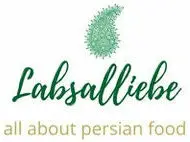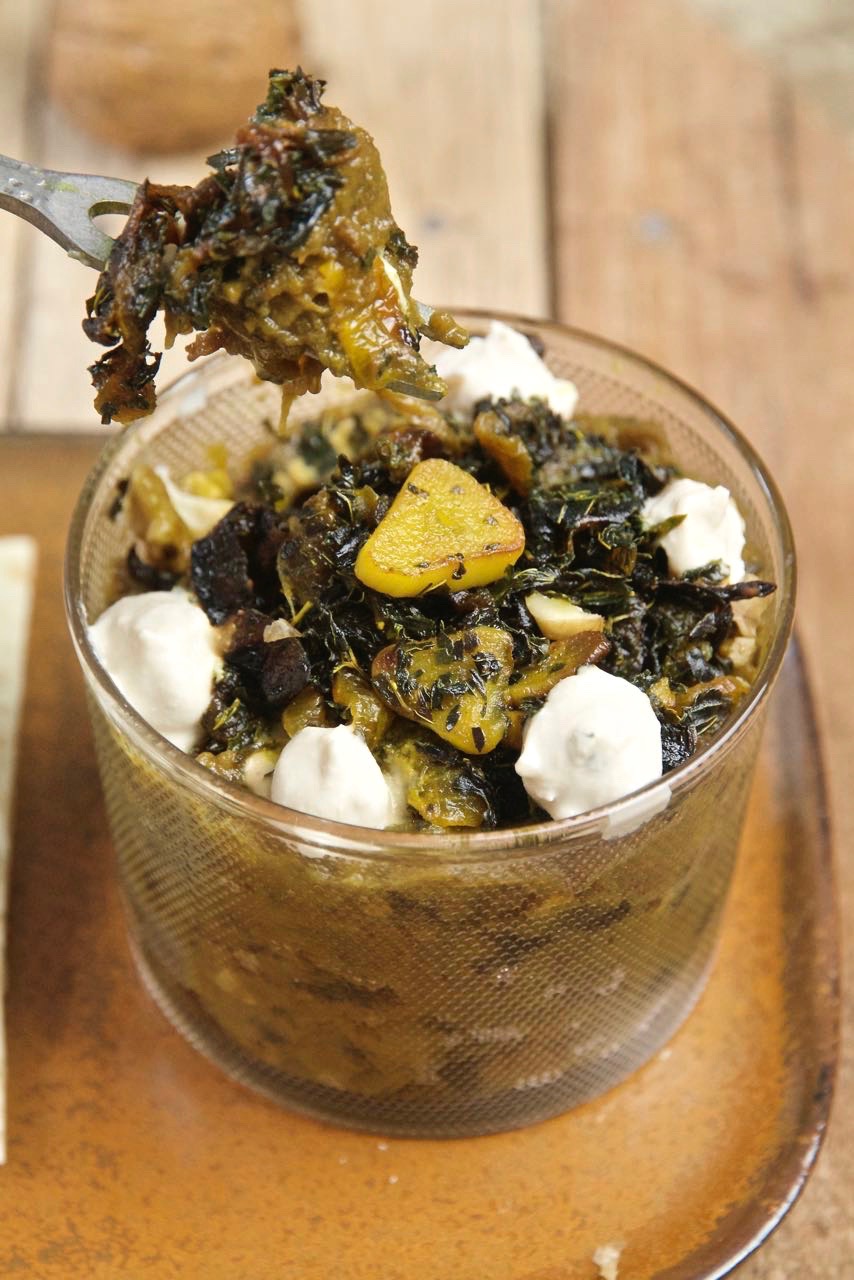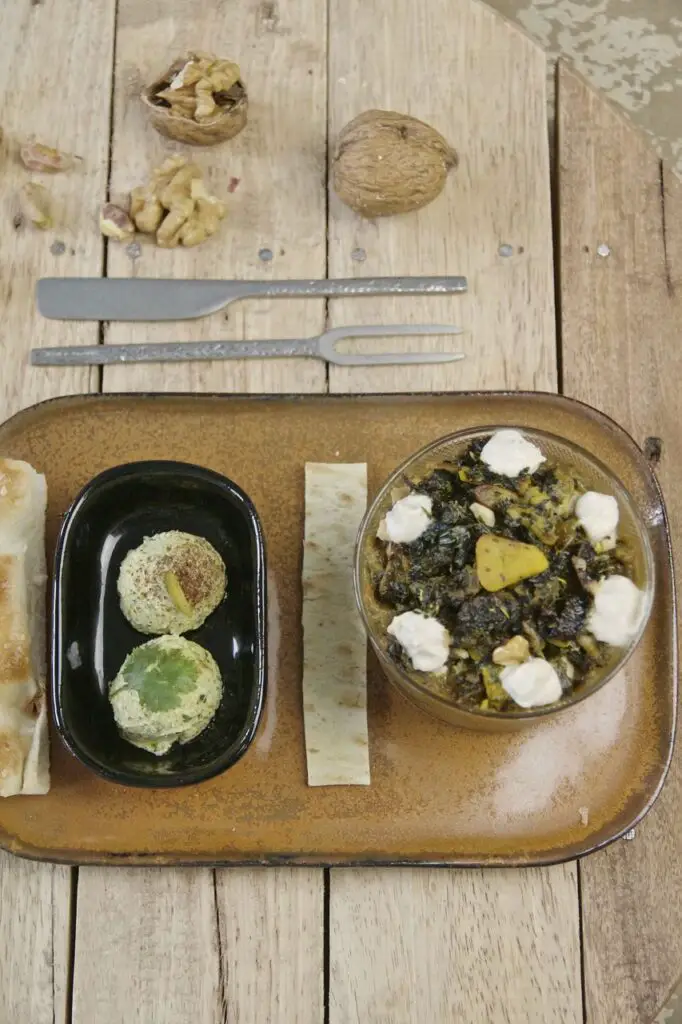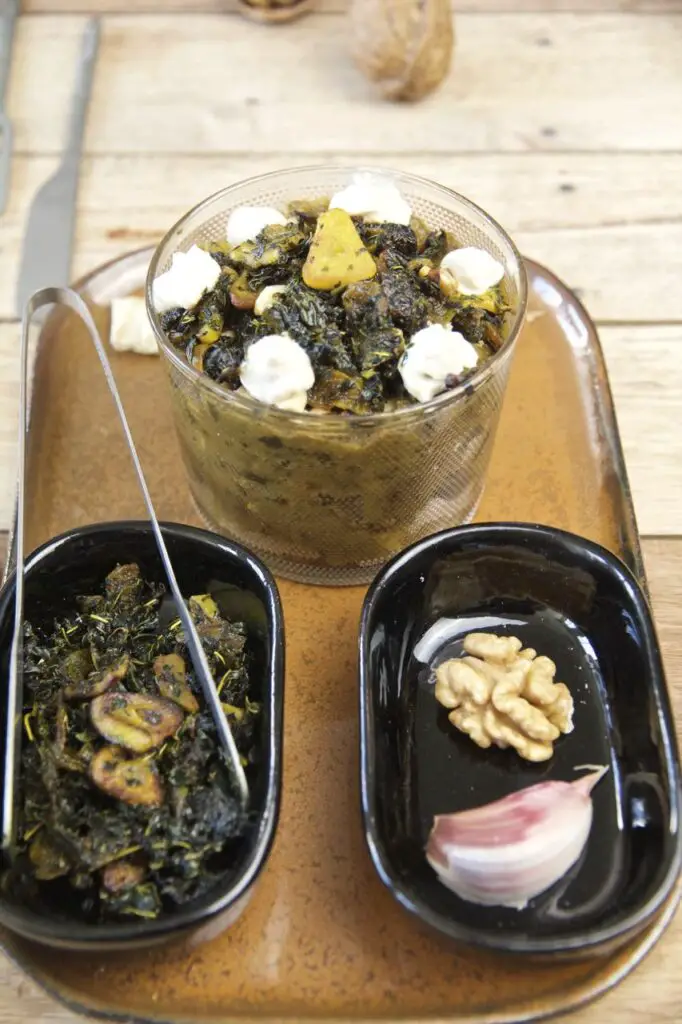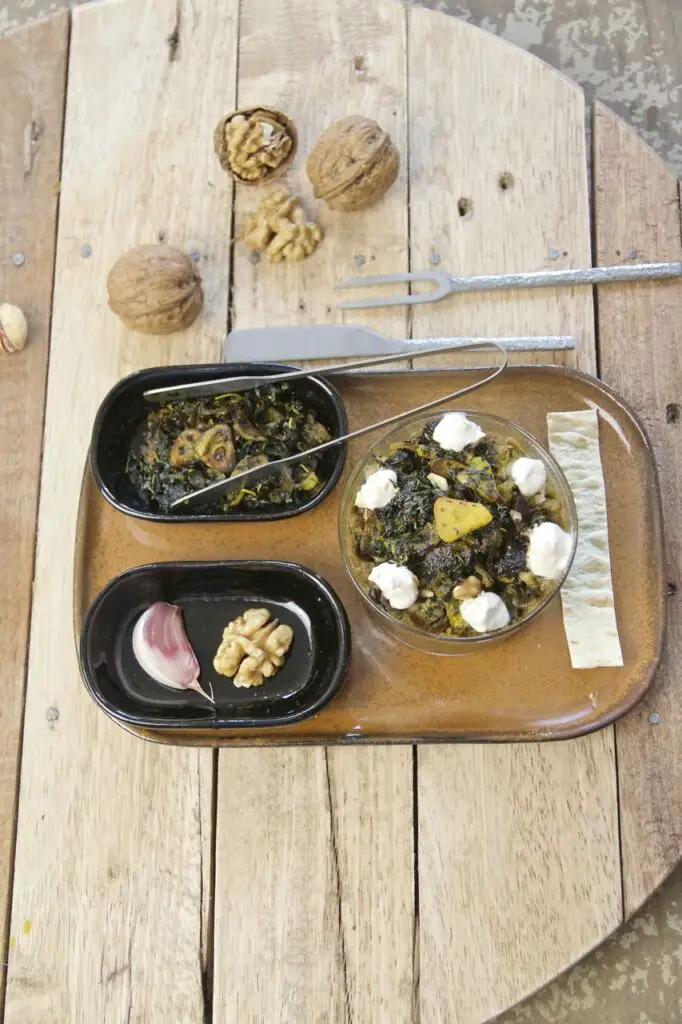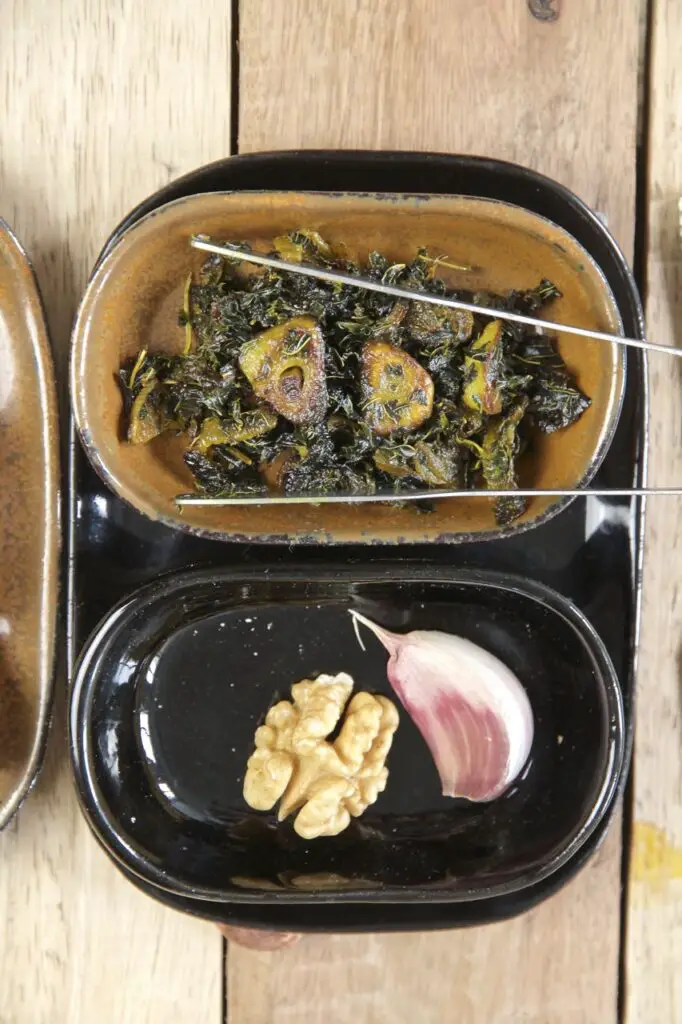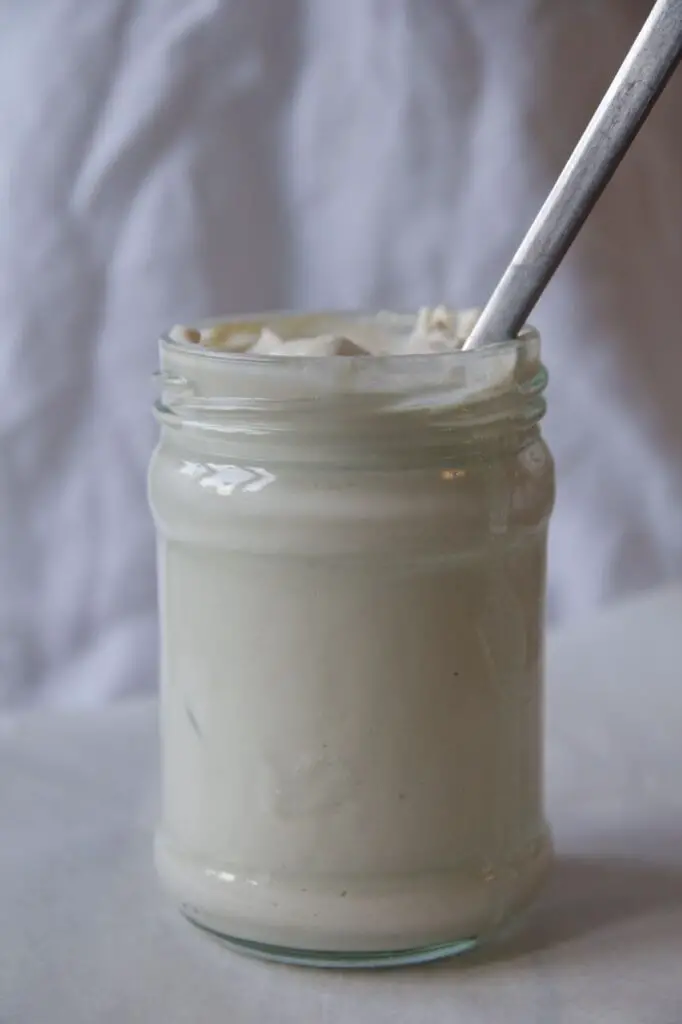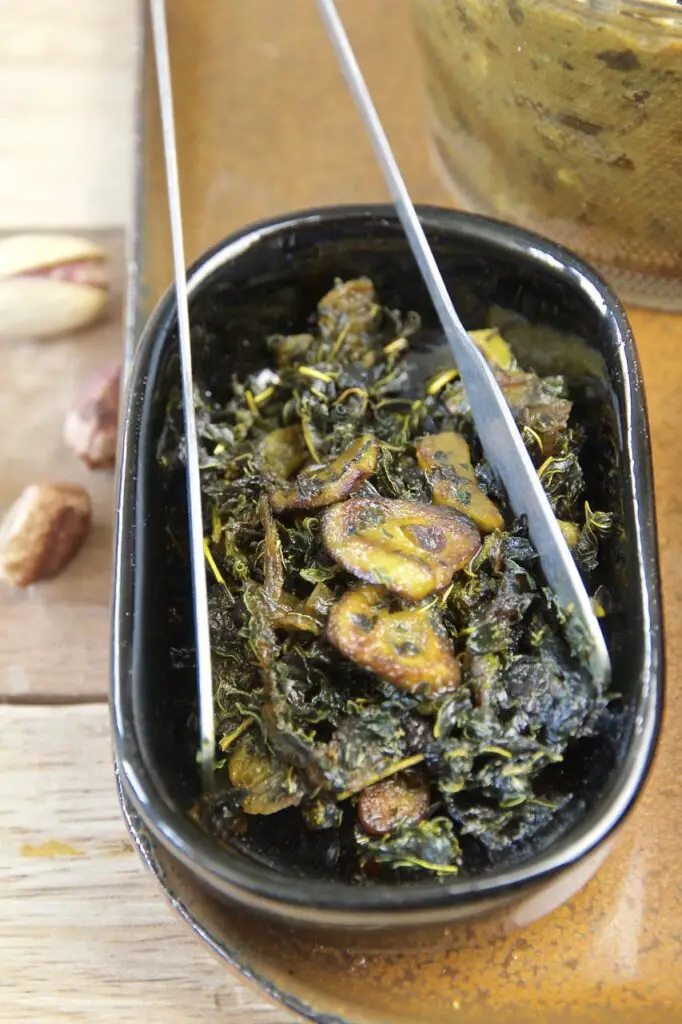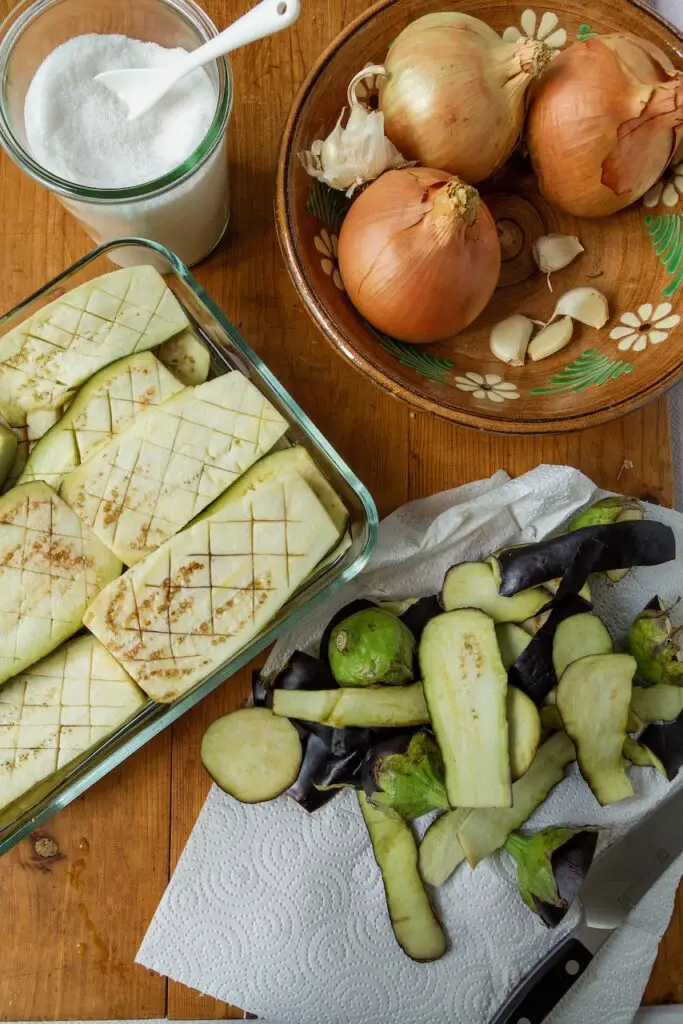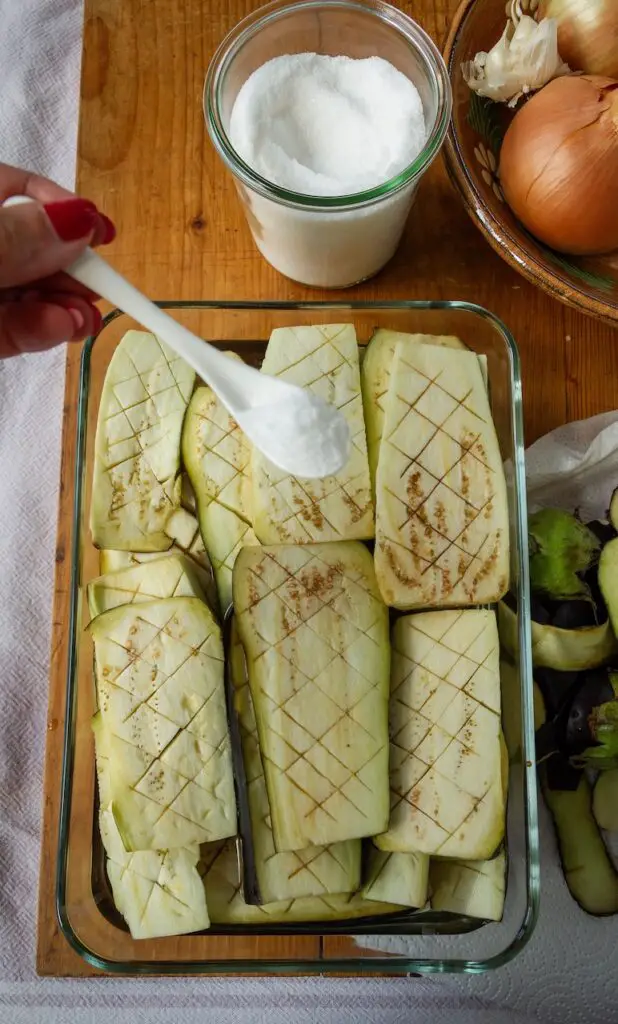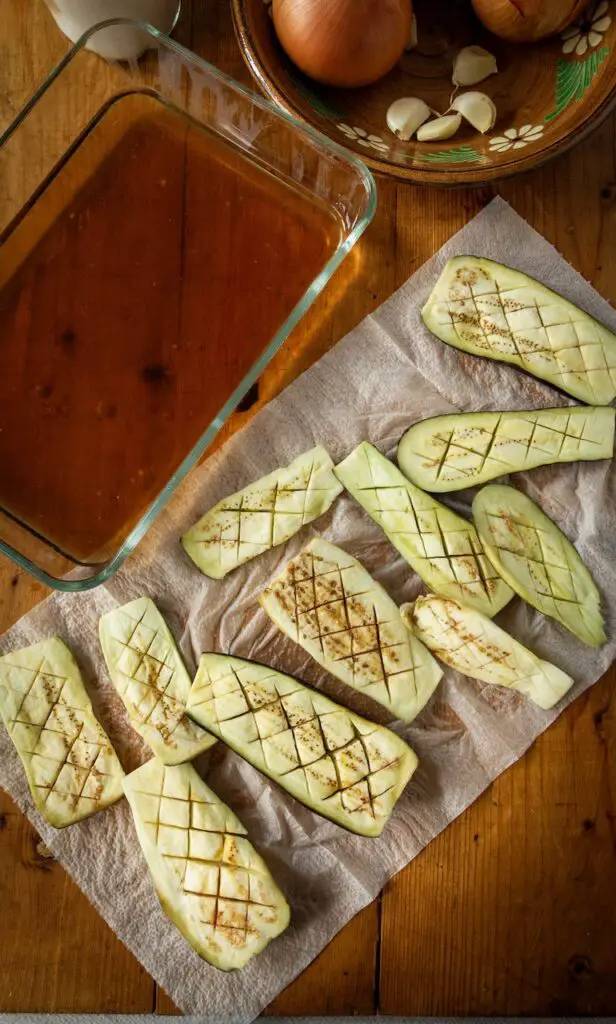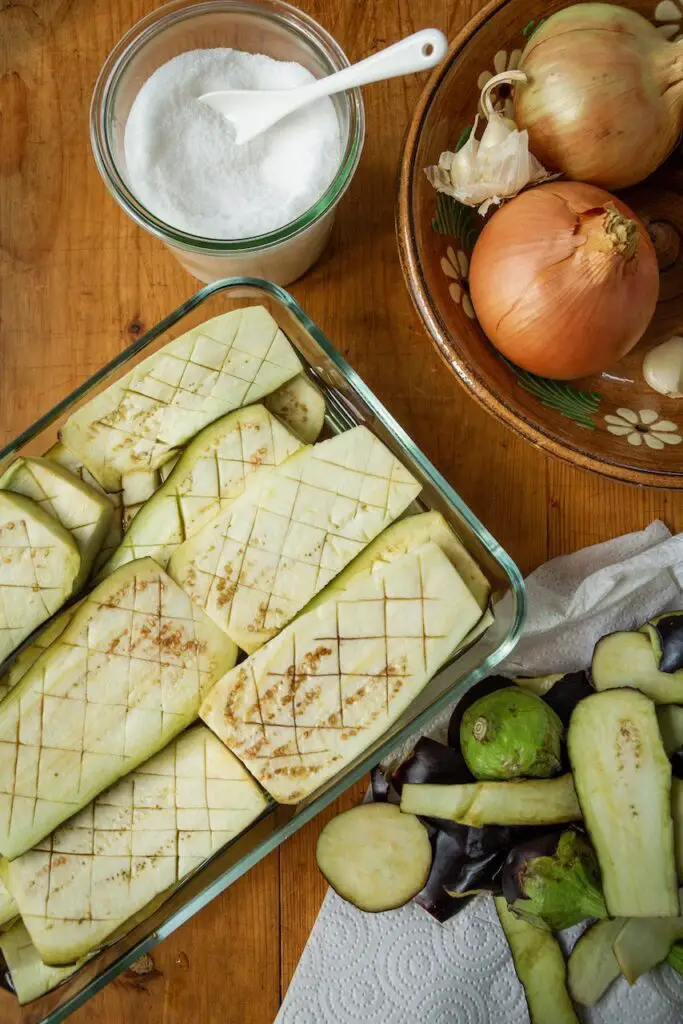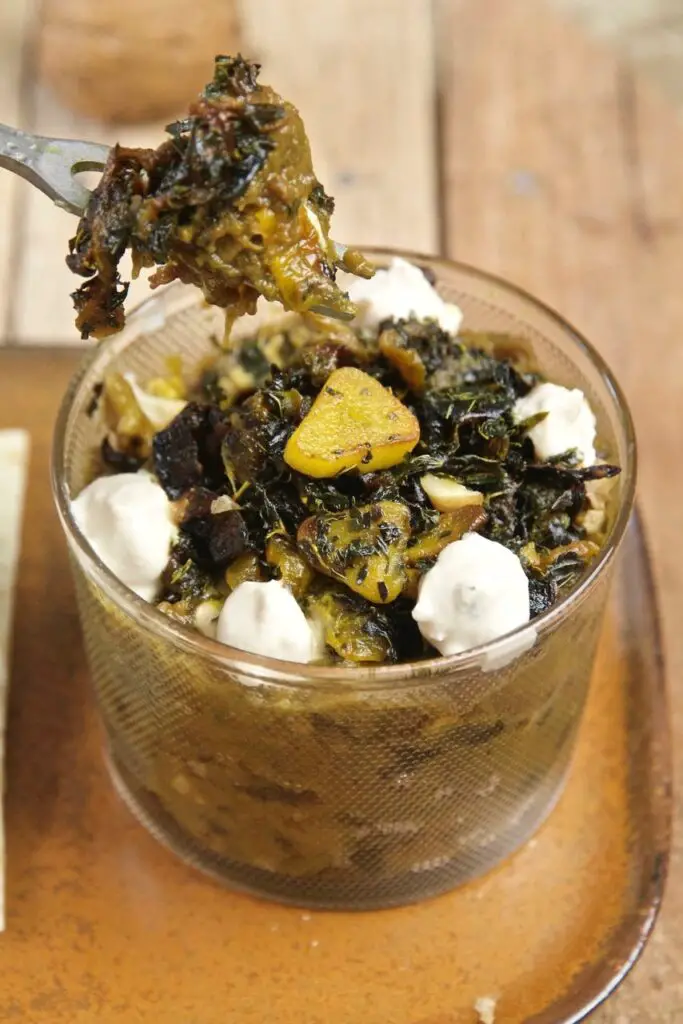Kashk-e Bademjan – Persian Eggplant Dip – is one of those dishes that stops you mid-bite. It begins with slow-roasted eggplants cooked until they turn into a soft, smoky puree. Into that silky base melt caramelised onions and garlic, a hint of turmeric and saffron, the warm crunch of walnuts, and, most importantly, kashk, the tangy fermented yogurt that gives this classic its signature flavour. Finished with piaz dagh – a crispy topping of onions, garlic and dried mint – every spoonful tastes creamy, smoky, sweet, tangy, aromatic and deeply comforting. This is the kind of dip you scoop with warm lavash bread and suddenly realise you’ve eaten half the plate. If you like Baba Ghanoush, you will absolutely love Kashk-e Bademjan.
This mezze tastes best with Persian Lavash or Barbari bread, but pita or flatbread also work well. Served warm, it’s simply delicious.
WHAT IS MAZEH?
The word “Mezze” comes from the Persian word “Mazeh,” which means taste. Persian cuisine is the origin of the mezze culture. Later, the sultans of the Ottoman Empire adopted these traditions, and from this a meal made of many small dishes developed. So we call all delicious Persian appetizers such as salads, vegetables, dips, herbs and small dishes that are eaten with bread, Mazeh.
Mazeh was also a popular companion to alcoholic drinks in Iran before alcohol was banned. In those days, people often gathered in homes or relaxed cafés, sharing small plates of dips, herbs, nuts and breads while enjoying wine, beer or aragh, a local spirit. The salty, creamy and aromatic flavours of Mazeh paired beautifully with drinks and turned simple evenings into warm, social gatherings. It wasn’t just food — it was part of a shared ritual, bringing people together around good flavours and good company.
KASHK-E BADEMJAN – PERSIAN EGGPLANT DIP
Kashk-e Bademjan is more than an appetizer. You can serve this dish either as a starter or as a main dish. You can either peel or cook the eggplants with the skin on. I roast mine unpeeled in the oven – if you do the same, make sure the skin is thin. But in my preparation video on Instagram I peeled the eggplant. Kashk-e Bademjan represents Iran’s culinary philosophy: simple ingredients transformed through time, patience and technique. Roasting the aubergines just right. Caramelising the onions until they’re sweet. Balancing kashk slowly, spoon by spoon. Adding the crunch of walnuts and the freshness of dried mint.
It’s a dish that brings people together — eaten from a shared platter, with warm bread torn by hand, with stories and laughter passed around just as generously as the food. This is what makes Kashk-e Bademjan so beloved worldwide. It’s not just a dip. It’s a moment, a memory, a warm welcome.
WHERE THIS LEGENDARY DISH COMES FROM
Kashk-e Bademjan comes from Iran, where eggplants have been used for centuries and where kashk has long been a treasured ingredient. The name itself means “kashk and eggplant,” a simple description for a dish with a surprisingly long history.
The origins lie in rural Persian cooking: families fermenting yogurt to create kashk, drying it so it would last through winter, then using it to enrich warm, nourishing dishes. Over generations, cooks combined the smoky flavour of roasted aubergines with the tang of kashk, adding saffron when available, plenty of onions for sweetness, and herbs such as dried mint. What started as a practical, rustic preparation slowly evolved into one of the most beloved appetizers in Iranian cuisine.
Today, Kashk-e Bademjan is served in homes from Tehran to Shiraz, in village kitchens and in modern restaurants. Each region prepares it slightly differently — some add more garlic, others more walnuts, some a deeper saffron infusion — but the soul of the dish remains the same.
WHEN IRANIANS SERVE KASHK-E BADEMJAN
Kashk-e Bademjan tells a story — a story of Persian kitchens, regional traditions, and the shared ritual of gathering around good food. Kashk-e Bademjan is a versatile and well-loved part of everyday eating in Iran. It appears:
- AT FAMILY DINNERS – Often placed on the table alongside warm bread as a starter or light meal.
- WHEN GUESTS COME OVER – A hospitable, generous dish served to welcome friends and loved ones.
- AT PARTIES AND GATHERINGS – One of the stars of the mezze-style spread (known as mazeh in Persian).
- DURING HOLIDAYS AND CELEBRATIONS – Sometimes paired with soups or festive dishes, adding richness and warmth to special meals.
- AS COMFORT FOOD – Served warm, it’s soothing, rich, and deeply satisfying, especially in colder seasons.
Even though it’s humble in ingredients, Iranians treat Kashk-e Bademjan as something worthy of guests — a dish that shows care, effort, and tradition.
WHAT IS KASHK?
Kashk comes in different forms – liquid, dried or powdered – and each version adds its own character to Persian dishes. Traditionally, kashk is made from fermented sheep’s yoghurt. First, the yoghurt is salted, heated and skimmed; then it is poured into a cloth or leather bag. After that, it hangs for several days so it can drain completely. Once the liquid is gone, the remaining paste is shaped into balls and dried. Later, when needed, the dried kashk is simply mixed with water to create a smooth, flavourful paste that can be added to cooked dishes.
Even today, in rural parts of Iran, drying yoghurt remains an important method of preservation. As a result, kashk has become a staple ingredient with a long history. It is white to greyish in colour and tastes similar to a strong, aged cheese – salty, tangy and full of deep flavour thanks to the fermented milk. Because of this unique taste, it is used in beloved dishes such as Kashk-e Bademjan and Ash Reshteh (Persian herb and noodle soup).
When cooking with kashk, remember to use it sparingly, as too much can make your dip overly sour. For best results, add it one teaspoon at a time and adjust to taste. Kashk can be replaced with sour cream if necessary; however, the dish will lose its distinctive Persian flavour.
PIAZ DAGH – CRISPY CARAMELIZED ONION, GARLIC & MINT
Piaz Dagh is a popular Persian topping and is served with many dishes. It is made of caramelised onions, garlic, turmeric, walnuts and dried mint. It adds incredible flavour to soups, burgers, and even hummus.
Make sure to use dried mint, as it has the bold, aromatic flavour needed for this topping. Piaz Dagh is also easier to digest than raw onions and becomes sweet, savoury and perfectly crispy.
INGREDIENTS FOR KASHK-E BADEMJAN
(Serves 4 as a main or 8 as a starter)
5 medium eggplants
Olive oil for brushing
1 medium onion, sliced
5 garlic cloves, sliced
½ tsp turmeric*
¼ tsp saffron threads*
Salt and pepper
6 tbsp liquid kashk*
PREPARATION KASHK-E BADEMJAN
Wash and dry the eggplants, cut off the ends.
Peel them or leave the skin on.
Slice into long pieces.
Score the flesh in a diamond pattern and salt well.
Leave for 30 minutes to draw out moisture.
Preheat oven to 200°C (390°F). Or prepare it in the Air Fryer (watch my video).
Pat eggplant dry, brush with olive oil and roast for 25–30 minutes until soft and brown.
Meanwhile caramelise the onions in hot oil for 10–15 minutes. Don’t burn them.
Add garlic and cook for another 10 minutes.
Remove from heat.
Grind saffron in a mortar.
Add roasted eggplants and ½ cup water to the onion-garlic mix.
Season with turmeric, saffron, salt and pepper.
Bring to a boil, reduce heat and simmer 10 minutes until the water evaporates.
Mash with a fork.
If you use dried kashk, mix it with water to create a smooth paste. Warm the kashk slightly with some more water to get a liquid kashk (do not boil).
Stir in 3 teaspoons of liquid kashk in the Eggplant mixure. Set the rest aside for the topping.
Remove from heat.
INGREDIENTS FOR PIAZ DAGH
1 tbsp olive or walnut oil*
1 tsp butter
1 large sweet onion
1 tsp turmeric*
5 garlic cloves, sliced
3 tbsp dried mint*
4 tbsp chopped walnuts (optional)
Salt and pepper
PREPARATION PIAZ DAGH
Heat oil and butter.
Slice onions thinly and caramelise for 10 minutes.
Add garlic and salt, caramelise another 10 minutes.
Add turmeric.
Remove from heat and mix in dried mint and walnuts.
Serving
Spread the Kashk-e Bademjan on a plate.
Top with Piaz Dagh, extra kashk and walnuts.
Serve with Lavash bread. Enjoy warm or cold.
Befarmayid
Susan
The items marked with * are affiliate links, referral links. If you buy through this link, I get a small commission. The price stays the same for you and you can easily support my efforts. A big thank you ♥
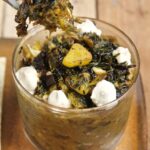
Kashk-e Bademjan – Persian Eggplant Dip
Kashk-e Bademjan – a rich Persian eggplant dip.
Ingredients
INGREDIENTS FOR KASHK-E BADEMJAN
- 5 medium eggplants
- Olive oil for brushing to your taste
- 1 medium onion sliced
- 5 garlic cloves sliced
- ½ tsp turmeric
- ¼ tsp saffron threads
- Salt and pepper to taste
- 6 tbsp liquid kashk
INGREDIENTS FOR PIAZ DAGH
- 1 tbsp olive or walnut oil
- 1 tsp butter
- 1 large sweet onion
- 1 tsp turmeric
- 5 garlic cloves sliced
- 3 tbsp dried mint
- 4 tbsp chopped walnuts optional
- Salt and pepper to taste
Instructions
PREPARATION KASHK-E BADEMJAN
-
Wash and dry the eggplants, cut off the ends.
-
Peel them or leave the skin on.
-
Slice into long pieces.
-
Score the flesh in a diamond pattern and salt well.
-
Leave for 30 minutes to draw out moisture.
-
Preheat oven to 200°C (390°F). Or prepare in the Air Fryer (watch my video).
-
Pat eggplant dry, brush with olive oil and roast for 25–30 minutes until soft and brown.
-
Meanwhile caramelise the onions in hot oil for 10–15 minutes. Don’t burn them.
-
Add garlic and cook for another 10 minutes.
-
Remove from heat.
-
Grind saffron in a mortar.
-
Add roasted eggplants and ½ cup water to the onion-garlic mix.
-
Season with turmeric, saffron, salt and pepper.
-
Bring to a boil, reduce heat and simmer 10 minutes until the water evaporates.
-
Mash with a fork or a knife.
-
If you use dried kashk, mix it with water to create a smooth paste. Warm the kashk slightly with some more water to get a liquid kashk (do not boil).
-
Stir in 3 teaspoons of liquid kashk in the Eggplant mixure. Set the rest aside for the topping.
-
Remove from heat.
PREPARATION PIAZ DAGH
-
Heat oil and butter.
-
Slice onions thinly and caramelise for 10 minutes.
-
Add garlic and salt, caramelise another 10 minutes.
-
Add turmeric.
-
Remove from heat and mix in dried mint and walnuts.
SERVING
-
Spread the Kashk-e Bademjan on a plate.
-
Top with Piaz Dagh, extra kashk and walnuts.
Recipe Notes
Serve with Lavash bread. Enjoy warm or cold.
Have you cooked this or maybe another delicious recipe of mine? Feel free to leave me a comment below. If you tag your picture on Instagram with @labsalliebe and use the hashtag#labsalliebe, I won’t miss a post and will be happy to leave you a comment as well. Can’t wait to see your creations.
♥♥♥♥♥♥♥♥♥♥♥♥♥♥♥♥♥♥♥♥♥♥♥♥♥♥♥♥♥♥♥♥
Sign up for my newsletter, and I’ll email you my latest recipes, travel reports, and trends once or maybe 2x a week for free.
